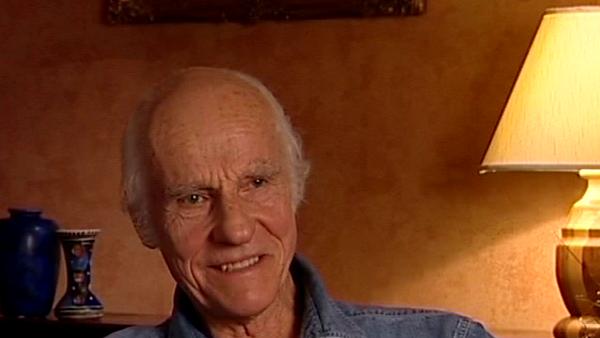NEXT STORY

Intercutting the love scene with the dawn scene in Women in Love
RELATED STORIES

NEXT STORY

Intercutting the love scene with the dawn scene in Women in Love
RELATED STORIES



We had some day for night shooting when Alan Bates and Jennie Linden are talking about death, because this young girl has just drowned, and they're talking about death and love. And we had this scene in the forest, which I shot day for night and I took the 85 off and put on a filter that we used for black and white, which was a 3N5. The number three was a kind of yellowy-green filter, so by taking out the 85 and just putting in some yellow I kind of got a bluey-green look, which I thought was quite nice for day for night, and I under exposed it about a stop and a third or a stop and a half to get the darkness. And we set up a shot on a long lens, a 400mm lens, so that I could hold the two of them about chest height and we marked out a circle so that the two of them could walk in a circle and the camera panned with them for about half this circle, so that they maintained the same distance from us. I put dark leaves in the foreground and because we were on such a long-focus lens everything except the actors was out of focus, so it had this very strange moody quality and we passed... they passed behind dark tree trunks, and there were a lot of dark areas in the shot, a very dark shot scene. The only light I used was a Brute right over the top of the lens with a soft diffuser on it, just to get a bit of light into their eyes, because when you're shooting day for night, or when you're shooting any very low-key scene and your faces are dark, you... you do need that little bit of light in the eyes to really capture the expression and the feeling and the mood that the actors are expressing. So I had this lamp, which had to pan with the camera, and it just gave enough light to read everything and... so we'd gone from this magic hour into what appeared to be full night, but in fact was day for night.
Billy Williams, London-born cinematographer Billy Williams gained his first two Oscar nominations for the acclaimed “Women in Love” and “On Golden Pond”. His third nomination, which was successful, was for the epic “Gandhi”. He was President of the British Society of Cinematographers, and was awarded the Camera Image Festival’s Lifetime Achievement Award in 2000.
Title: Shooting the day for night forest scene in "Women in Love"
Listeners: Neil Binney
Neil Binney began working as a 'clapper boy' in 1946 on spin-off films from steam radio such as "Dick Barton". Between 1948-1950 he served as a Royal Air Force photographer. From 1950 he was a Technicolor assistant technician working on films such as John Ford's "Mogambo" (photographed by Freddie Young), Hitchcock's "The Man Who Knew Too Much" (Bob Burke), and Visconti's "Senso" (G.R. Aldo/B. Cracker). As a camera assistant he worked on "Mind Benders", "Billy Liar" and "This Sporting Life". Niel Binney became a camera operator in 1963 and worked with, among others, Jack Cardiff, Fred Tammes and Billy Williams. He was elected associate member of the British Society of Cinematographers in 1981 and his most recent credits include "A Fish Called Wanda" and "Fierce Creatures".
Duration: 2 minutes, 38 seconds
Date story recorded: September 2003
Date story went live: 24 January 2008